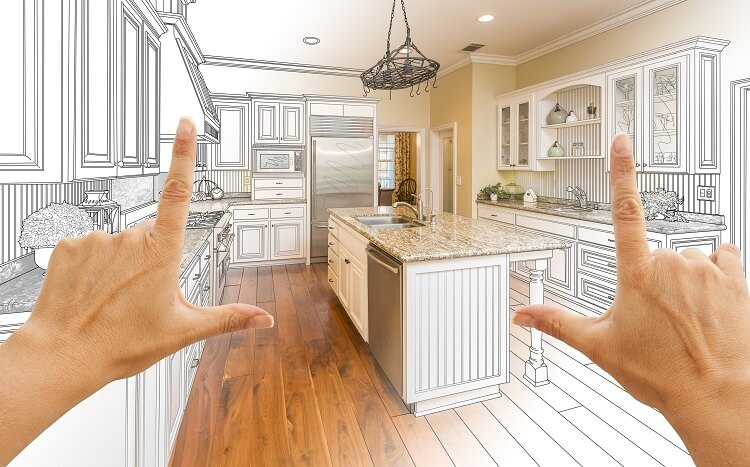From Guest Blogger Amelia Atkins: Ten Best Green Building and Design Ideas

Female Hands Framing Gradated Custom Kitchen Design Drawing and Photo Combination.
If you want to join the “green” movement and start doing something good for you and generations to come, you might want to consider making your next home energy-efficient and eco-friendly. Today, there are many ways you can boost your home’s greenness and sustainability, and these ten are probably the best way to start.
Location is the key
If you still don’t have a set location for your home, you’re in luck. This means you can avoid building in environmentally sensitive locations prone to earthquakes, forest fires and floods. This also means you can pick a location that is near grocery stores, schools and work facilities, so you don’t have to take the car every time you leave the house. However, if you already have your location, make sure to choose the proper orientation of your home to minimize heat or cold, depending on your geographic position.
The size matters
Everything to the side, if your home is big, it will require more building materials, more energy to light, heat and cool it, and it will cause a bigger impact on the environment. So, if you don’t need a home fit for a family of six, build accordingly.
Use green materials
The use of sustainable and eco-friendly materials is one of the key elements of green building. So, make sure your building materials, roofing, furniture, insulation and flooring are all environmentally friendly. Concentrate on materials such as reclaimed wood, recycled plastic and glass, sustainable bamboo and cork, and natural linoleum. Additionally, make sure to use materials that are local to your area. For instance, if you live in Australia, visit your local suppliers and opt for native Australian hardwood or laminate produced in your area. You can also decorate your home with wool carpets, natural stone and hemp linen. So, make sure to find experienced home builders in Sydney who are willing to cater to your every need, but still offer useful advice on how you can make your design better.
Insulation for an energy-efficient home
Aside from materials used for insulation, the way you insulate your home is also very important. You want to concentrate on eliminating energy leaks and thus reduce energy consumption and lower your utility bills. Pay special attention to your attic. Many people forget to insulate that part of their home and start to experience big air leaks.
High-quality windows and doors
Energy-efficient windows and doors are a relatively new green building element, but they already have many fans. Energy Star doors and windows not only reduce energy loss but also offer good sound insulation.
Green roof
If you want to boost your home’s energy efficiency even more, take a look at your roof. Today, there are amazing products that can reflect the sun’s energy away from your home. Slate, terra cotta, special white tiles or membranes will all help reduce your cooling costs. There are also green living roofs that are built to hold plants that grow from the roof. They catch the rainwater, provide additional insulation and generally make the building more attractive and pleasant for living.
Invest in energy-efficient appliances
When equipping your home with appliances and gadgets, make sure to look for models that carry the Energy Star label. These appliances function exactly the same as your traditional ones but waste a lot less energy and water. They look super attractive, too!
Conserve water
Many parts of the world are experiencing frequent droughts, so water conservation should also be something to think about when designing your home. For instance, low flow faucets, toilets and showerheads use much less water which brings down your water bill and protects the environment.
Energy-efficient heating and cooling
Almost 50% of the electricity we spend in the household goes towards heating and cooling. One of the best ways to lower that number is to invest in energy-efficient HVAC systems that will help you save both energy and money. If you want to make your heating and cooling costs even lower, you can invest in a smart thermostat. This little gadget learns your habits, regulates the temperature in your home to reach the perfect levels, and minimizes the energy loss.
Don’t forget your outside space
Your landscaping can serve a bigger purpose than just be attractive to the eye. For instance, if you plant leafy trees and shrubs near your home, they can protect your interior from direct sunshine in the summer. On the other hand, when there are no leaves in the winter, sunshine will be free to come in and heat up your space.
Thanks to the green revolution and the people willing to join it, we will have a happier and healthier future and many natural wonders to show to our grandkids.
